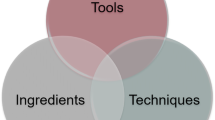Abstract
Learnability is a key factor in the out-of-box (OOBE) experience. This paper is a conceptual analysis of learnability in the context of OOBE. We first analyse the concept of learnability in terms of different views of learning. Then we discuss how metaphors could be utilised as a way of making learnable products which provide a positive OOBE. We also present a method for analysing individual learning processes during the first few moments with a new product 7 and illustrate the use of the method with a description of the evaluation of a sample design. Finally, we derive some design guidelines relevant to OOBE.






Similar content being viewed by others
References
Nielsen J (1993) Usability engineering. Academic, Boston
Preece J, Rogers Y, Sharp H, Benyon D, Holland S, Carey T (1994) Human-computer interaction. Addison-Wesley, Wokingham
Shackel B (1984) The concept of usability. In Bennett J et al (eds) Visual display terminals. Prentice Hall, Englewood Cliffs, pp 45–87
Shneiderman B (1998) Designing the user interface: strategies for effective human-computer interaction, 3rd edn. Addison-Wesley, Reading
Kuhn TS (1970) The structure of scientific revolution, 2nd edn. University of Chicago Press, Chicago
Merriam S, Caffarella RS (1999) Learning in adulthood: a comprehensive guide, 2nd edn. Jossey-Bass, San Francisco
Ertmer PA, Newby TJ (1993) Behaviorism, cognitivism, constructivism: comparing critical features from an instructional design perspective. Perform Improv Q 6(4):50–72
Skinner BF (1980) Beyond freedom and dignity, 12th edn. Alfred A. Knopf, New York
Jonassen DH (1991) Objectivism versus constructivism: do we need a new philosophical paradigm? Educ Technol Res Dev 39(3):5–14
Skinner BF (1985) Cognitive science and behaviourism. Br J Psychol 76(3):291–301
Chomsky N (1973) For reasons of state. Pantheon, New York
Jonassen DH (1994) Thinking technology: toward a constructivist design model. Educ Technol 34(4):34–37
Cooper PA (1993) Paradigm shifts in designed instruction: from behaviorism to cognitivism to constructivism. Educ Technol 33(5):12–19
Fitts PM, Posner MI (1967) Human performance. Brooks/Cole, Belmont
Anderson JR (1983) The architecture of cognition. Harvard University Press, Cambridge
Card SK, Moran TP, Newell A (1983) The psychology of human-computer interaction. Lawrence Erlbaum Associates, Hillsdale
Aristotle (1984) The complete works of Aristotle: the revised Oxford translation/ed. by Jonathan Barnes, 1st edn, vol. 2. Princeton University Press, Princeton
Lakoff G (1993) The contemporary theory of metaphor. In: Ortony A (ed) Metaphor and thought. Cambridge University Press, Cambridge, pp 202–251
Lakoff G, Johnson M (1980) Metaphors we live by. The University of Chicago Press, Chicago
Lakoff G, Johnson M (1999) Philosophy in the flesh: the embodied mind and its challenge to western thought. Basic Books, New York
Pirhonen A (2004) To simulate or to stimulate? In search of the power of metaphor in design. In: Pirhonen A et al (eds) Future interaction design. Springer, Berlin Heidelberg New York
Gentner D, Nielsen J (1996) The anti-mac interface. Commun ACM 39(8):70–82
Harrison BL, Fishkin KP, Gujar A, Mochon, C, Want R (1998) Squeeze me, hold me, tilt me! An exploration of manipulative user interfaces. In: CHI’98. Conference proceedings on Human factors in computing systems. ACM Press, Los Angeles, pp 17–24
Johnson J (1987) How faithfully should the electronic office simulate the real one? SIGCHI Bull 19(2):21–25
Nardi BA, Zarmer CL (1993) Beyond models and metaphors: visual formalisms in user interface design. J Vis Lang Comput 4: 5–33
Pirhonen A (2002) What do learning curves tell us about learnability? In: Vetere F et al. (eds) Proceedings of the HF2002 human factors conference, “Design for the whole person-integrating physical, cognitive and social aspects”, Swinburne University of Technology, Melbourne, 25–27 November 2002, CR-ROM format
Pirhonen A, Brewster S (2001) Metaphors and imitation. In: Rachovides D et al (eds) Workshop proceedings in PC-HCI2001: integrating metaphors, multimodality and multimedia, Patras, 7–9 December 2001, pp 27–32
Pirhonen A, Brewster S, Holguin C (2002) Gestural and audio metaphors as a means of control for mobile devices. In: Proceedings of CHI2002, Minneapolis, 20–25 April 2002. ACM Press, New York, pp 291–298
Brewster SA, Wright PC, Edwards ADN (1995) Experimentally derived guidelines for the creation of earcons. In: Adjunct Proceedings of HCI’95, Huddersfield, pp 155–159
Anderson JR (2000) Cognitive psychology and its implications, 5th edn. Worth Publishers, New York
Bereiter C, Scardamalia M (1993) Surpassing ourselves: an inquiry into the nature and implications of expertise. Open Court, Chicago
Carroll JM, Mack RL (1985) Metaphor, computing systems, and active learning. Int J Man Machine Stud 22(1):39–57
Acknowledgements
This work was funded by the National Technology Agency (Finland). Special thanks to Prof. Stephen Brewster for cooperation and Dr. Liz Sillence for her valuable help in writing.
Author information
Authors and Affiliations
Corresponding author
Rights and permissions
About this article
Cite this article
Pirhonen, A. Supporting a user facing a novel application: learnability in OOBE. Pers Ubiquit Comput 9, 218–226 (2005). https://doi.org/10.1007/s00779-004-0323-6
Received:
Accepted:
Published:
Issue Date:
DOI: https://doi.org/10.1007/s00779-004-0323-6




